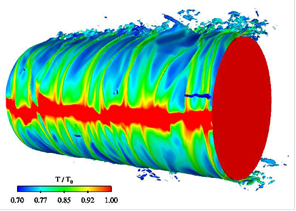This research focuses on the numerical study of flows in turbomachinery (as found in e.g. jet engines). This type of flow is highly unsteady and therefore difficult to understand. With the help of accurate numerical simulations the physics that play a role in these types of flows is explored. For example: the front part of a turbine blade experiences a high thermal loading because of the impinging hot exhaust gases from the combustor. It was found that the level of the free-stream turbulence in the exhaust gases significantly affects this thermal loading, which may potentially damage the turbine blades. Numerical simulations such as those shown in figure below are performed to identify and understand the physical mechanisms that are responsible for this increase in heat transfer. The newly achieved understanding can subsequently be used to improve existing models and to design new models to be employed in industrial codes that are routinely used to calculate flows in turbomachinery. With these new models, a more accurate prediction of the thermal loading on turbine blades can be obtained which helps, for example, in the development of more efficient blade-cooling strategies.
 A hot cylinder is cooled by oncoming cold flow that contains free-stream fluctuations. The picture shows the boundary layer around the cylinder, coloured by the temperature
A hot cylinder is cooled by oncoming cold flow that contains free-stream fluctuations. The picture shows the boundary layer around the cylinder, coloured by the temperature